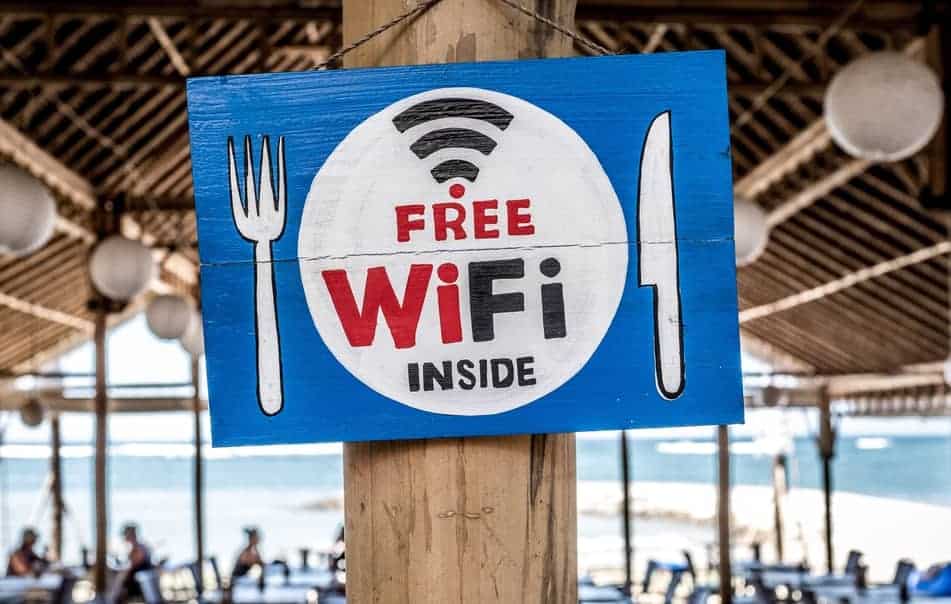
Wifi and water should be put in the basically the same human need hierarchy level. Kidding.
But really, it is more common than not to quickly feel a panic or loss when we discover that our router loses signal or internet rolls at a turtle’s pace. So what is the average the average wifi speed?
The average wifi speed ranges between 2 to 20 Megabytes per Second, where some signals can peak above 50 mb/s. Internet service plan, radio interference, router and device capability, and signal strength can all impact how fast the wifi speed is actually tested within the area.
There will almost always be a disparity between the actual wifi speed and the theoretical speed that the internet service provides. Depending on the factors listed above, you can easily troubleshoot your way to faster wifi. I dive in to show my findings about wifi speed in more detail below.
Wifi vs Wired Internet Connection
Wifi connections have become the norm, so much so that ethernet cables are collecting dust or just don’t even exist in many households anymore.
The convenience that wifi provides, like being able to surf the internet from your laptop outside, or watching tv from a wireless cable box, has made wired internet connectivity all but a past-time.
But even wifi still contains a lot of wires. In fact, the connection between the router and the internet service provider are very much wired. The only difference between wifi and wired connection is the last point between the ethernet port in the office or home, and the device.
Instead of using an ethernet cable to hardwire a device to the active ethernet port, wifi makes the two points completely wireless by introducing an ethernet router into the mix.
This router takes all the wired information from the port and emits a radio signal throughout the area that is then received by the capable device.
The Importance of Understanding Wifi for Max Speed
Like when a cell phone loses signal because it’s obstructed from a cell phone tower, or simply too far away, a wifi signal works in much the same fashion.
If a device is too far from the wifi access point, or router, the speed of internet will act progressively slower until, eventually, it loses signal.
When a router is within a house or office, its signal also has to go through walls, ceilings, roofs, last night’s pizza box, etc. The more objects that stand in the way of the router and a device impacts the wifi signal, and thus speed, negatively.
So hopefully now you can tell that wifi routers and wireless devices really like clear open paths.
But First, A Quick Tip for a Speed Boost
Before I get into the technical details of device and router generations and their resulting capabilities, I want to suggest here again that by simply creating the clearest and closest path between whatever device you are using and the router will for sure improve the wifi speed.
However, if you feel clearing objects or walls is a daunting task in the name of faster speed, or you like where the device is sitting and don’t want to move it, then a wifi extender can also improve the wifi signal in the area.
Wifi extenders, also called boosters, capture the radio signal from the original router and amplify it so that it expands its wireless reach.
These are great for older homes or offices with plaster walls, and places where the routers’ only connection is buried somewhere deep in a closed room like a basement or closet.
Wifi Standards: Router and Device Capability
The Institute of Electrical and Electronics Engineers (or IEEE as you might have seen on some product labels) certifies standards for wifi signals in the US, and technological advances have allowed them to create new ones every few years that can handle faster internet speeds.
Like electronics, wireless routers too can become out of date because they are built to only handle a certain maximum wifi speed, even if the current standard is much higher.
This means that even if you are paying for lightning fast internet service, say 200 mb/s, and you are using a router that runs 802.11a signal, then your actual speed can only be as fast as about 20 mb/s.
Of course, if you are only paying for a slower internet service package, then older routers are adequate enough to handle these signals.
But in many cases, if you have owned the same wireless router for more than a few years, then it’s time to upgrade the router so that it can emit a wifi signal that matches the best standard, which is 802.11ac and can handle speed of up to 1.3 Gb/s.
(there should also be an 802.11ax standard of signal that’s supposed to roll out soon that will handle even faster speeds!)
The same limitation can be said of devices as well. Older electronics that are only capable of handling earlier standards of wireless internet, like 802.11a or b, cannot run wifi signal any faster, even if the router has the more modern standard.
The key takeaway here is that the speed of the wifi can only work as good as its weakest link. Be sure to take note of what wireless standards of your router and devices are and see if one needs to be upgraded in order to achieve the maximum signal output.
More Devices Used on the Same Network Affect Average Wifi Speed
Have you ever noticed that the wifi was streaming along just fine when all of a sudden webpages stopped loading or your favorite Netflix show started buffering?
That’s because if there are multiple devices used on the same network, each one takes up a piece of the router’s pie. So for instance, if a router is emitting 20mb/s of signal and 4 devices are on the same network, then each one has to share a portion of that 20mb/s.
This means that for households with larger families that are into electronics or if you just like to have many devices in use at the same time, it’s best to not only have the latest standard wireless router and device, but also to upgrade the internet service to a faster package.
Certain Demands for Wifi Speed are Important Too
No two internet tasks are alike. At least when that’s comparing tasks like checking email and typing up a spreadsheet versus gaming with Call of Duty online with friends.
Depending on how many megabytes per second a job requires, that will determine how much speed is needed from the wifi router. Even if one device is on a network, if that one device requires speeds above what the router and service are providing, then there will be excessive streaming buffer times or lag while gaming.
If you plan on doing lighter tasks within your network that do not require that much wifi speed, then you should be more than fine with most internet providers’ starter packages. Anywhere above 5mb/s should be fine for most jobs like this.
On the other end, if you find yourself in a network with a lot of online gaming devices, or want to stream all your video in smooth 4K picture clarity, then upgrading to a faster internet package will allow you to achieve quicker wifi speeds. Super high-definition on average requires above 10mb/s signal and online gaming above 20mb/s.
This is provided you are also sure that all the standards of the router and devices are completely up to date so that they are capable of passing through the faster speed throughout the area.
An Interesting Fact About Modern Routers
Did you know a router only has one signal that it can emit to each device in its network?
When you boot up one online device, that activates the router to talk to it using one signal output.
However, when more than one device is online, the router uses a rapid-fire succession of signal output to bring wifi to each device. This is so fast that we never really realize that it is switching in between each device.
Be Mindful of Radio Interference
Older routers used to operate at a 2.4GHZ radio frequency to emit its signal to devices in the network.
Today, newer routers run at 5GHZ to produce the same signal. But there are also electronics that can emit similar radio frequencies as routers too.
Think wireless house phones, music radios, home theater systems. These units can create a radio interference with the wifi signal if they cross the same path of frequency.
Some modern routers have what’s called dual band capability to combat this disturbance so that users can log on to either frequency and get the same wifi.
The more similar radio frequencies interfere with each other in the same area as the wifi network, the harder it is for the signal to receive a clear route between the device and router.
Also, the distance between similar radio frequencies affects its interference. The closer they are to each other the larger the interference.
So if you discover that your router is interfering with another electronic that is emitting the same radio frequency, try to separate the two as far away as you comfortably can from each other so that there’s less risk of continuous interference in the future.
